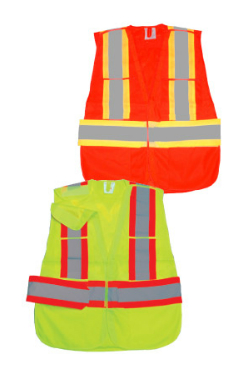Safety Vests: Get To Know the Different Classes
December 18, 2013 · by Ten Medina
Visibility is an important part of job safety, especially if you work in industrial or construction sites. These jobs require you to perform tasks close to moving vehicles and equipment in different weather and light conditions. You need to be highly visible at all times to avoid accidents and injuries. Which is why for the Canadian workplace, wearing a safety vest is a must, and a legal requirement.
Safety vests are Personal Protective Equipment (PPE) designed to make the wearer more visible to others. These come in bright, neon coloured fabric and feature strips of reflective tape which reflect the light from headlights of moving vehicles. Workers who wear safety vests are easier to spot, even from a distance or in low light conditions. As a result, accidents are reduced since motorists and machinists can easily see the workers wearing the high-visibility vests.
When it comes to choosing the best safety vests, you can use this handy guide on choosing safety vests to help you in your decision. Aside from this, you also need to know the different classes of safety vests and their application so you can comply with the Canadian Centre for Occupational Health and Safety (CCOHS) regulations:
Class I
Class 1 vests provide minimal amount of bright and reflective material, usually in orange, yellow, and lime green. They are used for occupational activities with low traffic, meaning the worker must have ample distance from the approaching traffic. Vehicle speed should not exceed 25 mph, and the worker must have his full attention to approaching traffic. These vests are ideal for sidewalk maintenance workers, parking attendants, and shopping cart retrievers.
Class II
Class 2 safety vests are worn by people who need greater visibility in areas of high traffic, dangerous weather conditions, and complex backgrounds. People who work in construction, law enforcement, emergency response, and utility fields need to wear this type of safety vest.
Class 2 safety vests are worn over the top of uniforms or shirts and come in fluorescent orange, lime, or yellow. Several styles of class 2 vests are available including adjustable variants, illuminated, mesh, and even vests made of flame retardant material. Usually, the vest also displays the company or department logo for identification purposes.
Class III
Class 3 safety vests offer the highest level of visibility and are required to be worn by workers on federal road right-of-ways when exposed to traffic or construction. They must be worn by workers performing heavy-duty tasks in limited or no light conditions, in areas of higher traffic in excess of 50 mph, or in extreme weather conditions.
Class 3 safety vests provide visibility through the full range of body motions from a distance of at least 1,280 feet. Similar to the Class 2 vests, they can also be imprinted with a department or company name, and come in fluorescent yellow, lime, or orange. You can choose from a variety of materials such as rubber, mesh, and non-mesh. A variety of styles for these vests are available from the common jacket to even overcoats and sweatshirt like apparel.
Maintaining high visibility should be a priority. You need to make sure that you and your workers are wearing the correct safety vests for your specific tasks when applicable. Wearing a safety vest lets you avoid unnecessary accidents and keeps you and your workers safe, enabling you to do your jobs properly. Always make sure you are wearing the right protective clothing before performing any task. This can spell the difference between an accident-free work zone and an accident-prone work zone.
For Original Article Click:
Safety Vests: Get to Know the different Classes



